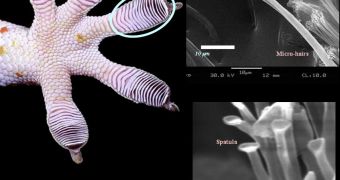Gecko lizards are amazing due to their capacity to walk on walls and upside down on the ceilings. Lizards' ability to defy gravity and attach to smooth surfaces like glass is due to their setae, hair-like structures of their feet. They do not secret glue, but use weak molecular forces, called Van der Waals, to get stuck to any surface (except Teflon). Friction is involved too. This creates adherence and thousands of small hairs create enough power to defeat gravitation. Synthetic material imitating this could be an alternative to Velcro and would be extremely useful in medicine for replacing chemical adhesives, but the U.S. Army too is interested in creating gecko-mimicking robots that can climb any surface.
Now, a team at University of Calgary has made another step towards achieving gekkotan adhesives, on a research published in the "Canadian Journal of Zoology".
"Unlike most creatures, geckos don't use sticky secretions to help them hang on, it's all due to the structure of their amazing skin. Figuring out how they are able to run across ceilings and walk up windows is remarkably complex but it is getting a lot of attention because of the possible technology it could yield", said co-author professor Anthony Russell, one of the world's leading experts on the gecko.
"Almost all of the research that has been done has looked at how geckos can walk on glass and other smooth surfaces, but of course their feet evolved for moving over very different surfaces. By looking at how they climb up rocks and other natural surfaces we are hoping to gain an even better understanding of their adhesive system because coping with rough and unpredictable terrain poses quite different problems than does smooth and even ones. This calls for examining both the animals and the terrain they use at the microscopic level", said Russell.
Tree frogs, tarantulas and many insects employ glue-like fluid to get a grip, but geckos' technology is dry. The new research made on south African geckos inhabiting rocky habitats concluded that the setae could have evolved in order to confer geckos traction on rugged surfaces, as just a small area of each toe pad can be used for maintaining a grip.
"It's kind of like the tire of a car. You have a large area of tread but at any moment in time, there's only a tiny portion that is actually in contact with the road, and you are depending on that to do the job in a variety of circumstances", said Russell.
"The goal is to create a completely dry adhesive that doesn't leave any residue behind and will remain attached as long as you apply a load to it and can be re-used an unlimited number of times. Once we conquer how it works it could be reasonably cheap to manufacture and the possible uses are endless. This nano-technology has been around for over 50 million years and we are only just beginning to understand how it works", he added.

 14 DAY TRIAL //
14 DAY TRIAL //